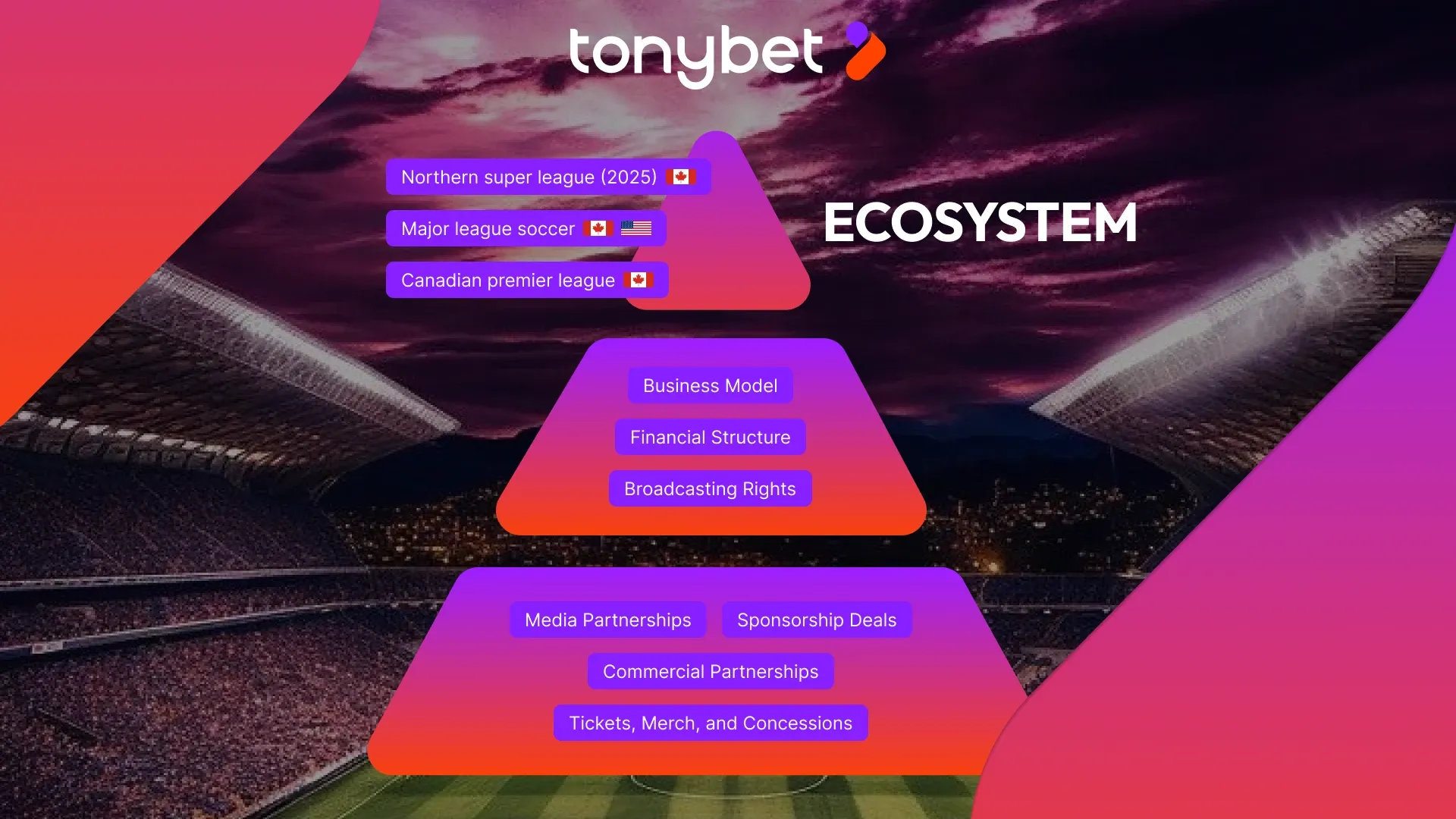Ask any CPL club accountant where the real money comes from, and you’ll get a turf-wide roll call – national broadcast fees on OneSoccer, jersey sponsors stitched across every chest, halftime beers poured by local craft breweries, even camp registrations for U-12s who wear next year’s kit before the pros do. Together, these channels form the “off-pitch engine” that keeps stadium lights on from Langford to Halifax.
The league negotiates the big-ticket deals – media rights, official ball contracts, front-of-shirt partners – and funnels a set share to each franchise. Clubs, meanwhile, hustle on home turf: match-day concessions, premium seating pods, community ownership shares, and pop-up merch trucks parked outside summer festivals. A steady stream of e-commerce sales (those retro thirds don’t ship themselves) now rivals walk-up scarf tables, and digital collectibles have quietly become a new line in 2025 budgets.
Understanding the Canadian Soccer League System
Ask any sports fan to name Canada’s professional soccer system, and you’ll hear a few different labels from Canadian Pro Soccer League to even “that new domestic league.” All of them point to the same pyramid.
Eight CPL teams – from Pacific on Vancouver Island to HFX Wanderers on the Atlantic coast – anchor the top tier. Below them sit semi-pro competitions, such as League1 BC, and Ligue1 Québec, which feed talent upward and provide communities with affordable matchdays.
There are also three Canadian clubs – Toronto, Montréal, and Vancouver Whitecaps – that compete in Major League Soccer (MLS), which sits outside that structure as a U.S.-run top-flight competition.
There are no promotion and relegation yet, but money, players, and ideas still flow between levels. Clear governance rules, a single-entity framework, and shared league ownership ensure the CPL’s stability, while clubs manage local branding, fan outreach, and daily operations. That mix of central control and regional flavour is why CPL news keep showing up in headlines, even outside Canada.
CPL’s Business Model and Financial Structure
In 2025, the league announced that each club had to operate within a player compensation budget of CAD1.282 million, up from CAD1.125 million two years earlier. The CPL salary cap helps curb runaway spending while leaving room for star signings. Central costs, such as insurance, cross-country flights, and league tech, are pooled, while local income stays in-house.
Owners treat their stakes more like long-term investments than quick flips. Genuine dividends are uncommon because cash usually flows back into training grounds or data analysis tools. The model also creates real-world Canadian Premier League jobs, such as ticketing representatives, sports science interns, and kit room attendants, helping to grow a domestic soccer economy that barely existed a decade ago.
Broadcasting Rights and Media Partnerships
The biggest single cheque still comes from TV. In 2019, Canadian Soccer Business signed a 10-year, roughly CAD200 million deal with Spain’s Mediapro. Games are now streamed on OneSoccer, with select matches simulcast on traditional TV channels. The agreement combines national-team rights with every CPL fixture, guaranteeing distribution, steady royalties, and increasing viewership both at home and abroad.
Clubs also carve out side deals, such as pregame shows sponsored by local breweries, Spanish-language highlight packages for immigrant communities, and even VR clips aimed at kids.
CPL Expansion: Sponsorship Deals and Commercial Partnerships
League expansion serves two purposes: it widens the fan footprint and brings in fresh capital. As of 2023, the informal fee to join the CPL hovered around CAD8-10 million. In an interview with Transfermarkt earlier this year, commissioner Mark Noonan expressed his hopes to announce two new franchises for the 2026 season and reach at least fourteen clubs by 2030.
That expansion is powered by a strong sponsorship backbone. Macron supplies kits, CIBC handles fintech activations, WestJet covers charter flights, and Tonybet serves as the league’s official gaming platform. Every agreement bundles digital marketing, on-shirt logos, and community pop-ups. Locally, teams add grocery chains, universities, and credit unions to their own sponsor decks, striking a balance between scalability and a hometown feel.
Matchday Revenue: Tickets, Merch, and Concessions
You can’t run a club without filling seats. As reported by Transfermarkt, average league attendance in 2024 stood at almost 4,000, which doesn’t sound impressive until you remember that many venues hold fewer than 7,000 total.
Halifax averaged 6,117 fans per game during the 2024 CPL season – filling almost all 6,500 seats at Wanderers Grounds (prior to its 2025 expansion) – and then set a new club record with 7,049 on July 4, 2025. On July 1, 2024, Ottawa Life Magazine reported a “5,000-plus crowd” at TD Place, consistent with Atlético Ottawa’s 2024 season average of 5,273.
According to Ticketmaster, tickets typically range between CAD22 and CAD71. Beer and poutine lines move briskly, and stadium operators split concession cash with clubs so neither side bears the full logistics burden.
Merchandising keeps tills ringing on non-matchdays. Scarves dominate winter sales, while third kits spike every November thanks to early holiday shoppers. Distinct visual identities – like Pacific’s purple wave or Cavalry’s green chevron – help drive orders from outside Canada, giving clubs a rare form of international exposure.
Player – Manager Transitions
Veteran players, aware that their careers can end abruptly, often transition into front-office roles. The shift saves on outside consultancy fees, preserves locker-room credibility, and lowers scouting overhead. Salaried positions also provide stability, with performance bonuses acting like mini dividends tied to league standings.
Martin Nash illustrates this pathway perfectly: he made more than 200 appearances for the Vancouver Whitecaps, helping the team capture two USL-1 championships in 2006 and 2008. After retiring, he climbed the technical staff ladder and became head coach of York United FC in December 2021. On July 23, 2025, Vancouver FC appointed him interim manager (and academy director), ensuring his deep CPL know-how stays inside the league.
Coach – Manager Transitions
The same pipeline exists for coaches. Tommy Wheeldon Jr. at Cavalry juggles head-coach duties with a sporting director brief, bridging tactics and boardroom strategy. Internal promotions reduce staff turnover, protect club data, and streamline operations. Clubs that nail this transition spend less on executive recruiters and keep a cleaner identity.
Youth CPL Academies and Development Fees
Many CPL clubs have youth programs and aim to develop talent within their own walls, feeling encouraged by the league to invest in youngsters. For example, according to the 2025 CPL roster rules, teams are allowed to exempt up to CAD100,000 in U-21 salaries from the cap.
Whenever a home-grown player signs abroad, FIFA mandates that their prior clubs receive training compensation payments. They may be tiny, often four-figure cheques, but stack them across 10 players and several seasons and you have a respectable revenue stream.
More importantly, strong academies cut transfer outlays, boost fan engagement among local families, and make efficient use of existing infrastructure. In short, they are a textbook example of soccer innovation on a tight budget.
Player Transfers and Sell-On Clauses
Outbound moves remain the league’s secret weapon. When centre-back Joel Waterman jumped from Cavalry to Montréal, Cavalry pocketed a fee and inserted a double-digit sell-on clause.
The same logic applied to Mohamed Farsi’s move to the Columbus Crew. Years later, those clauses will kick in again, paying unexpected royalties without extra logistics or payroll. Smart contracts can fund youth pitches, GPS vests, or even new medical rooms.
Community Engagement and Local Economic Impact
Matchday isn’t just about 90 minutes of play. Fans pay for bus rides, restaurant meals, post-game drinks, and hotel beds. Municipal studies estimate the annual ripple at millions of dollars per market.
Clubs return the favour with school clinics, refugee tournaments, and charity auctions – initiatives that deliver priceless community exposure. Local governments sometimes respond by offering stadium-lease breaks or funding for roof repairs, thereby lowering long-term infrastructure costs.
Future Growth Opportunities in the CPL Ecosystem
Three levers sit on the horizon:
- CPL expansion into Québec City, Kelowna, and potentially Windsor would unlock new regional sponsors and tap into hungry fan bases.
- A refreshed broadcast package mixing linear TV, streaming micro-subscriptions, and three-minute clips to capture Gen-Z attention.
- New verticals – digital collectibles, data licensing, even AI tactical tools – that add margin without bulky hardware.
Combine these with disciplined costs, and several teams could expect to turn a profit within two seasons. For job seekers, this means more front-office roles, such as a ticket analyst or a women’s program lead – another boost for professional soccer teams in Canada and the broader talent pipeline.
FAQ
How does the CPL generate revenue beyond player salaries?
Media rights, matchday takings, merchandise, sponsor cash, outbound transfers, and academy training compensation form the mix. Together, they smooth out seasonal dips and protect clubs from a single-source shock.
What role do sponsorships play in CPL finances?
Sponsorship money – from national brands like CIBC to local breweries – pays for travel, upgrades venues, and widens marketing reach. Some deals even cover entire kit orders, freeing up cash for things like rehabilitation technologies.
Are CPL clubs profitable?
Most still operate in growth mode, but rising attendance, new partnerships, and tighter budgets mean a handful expect positive cash flow by 2026. Winning helps, yet disciplined books matter more.
How do player transfers contribute to club revenue?
Transfer fees deliver immediate cash. Sell-on clauses pay later. Together, they turn local prospects into recurring revenue streams, supporting everything from academy expansions to stadium upgrades long after a player moves on.





 Borys Budianskyi
Borys Budianskyi 